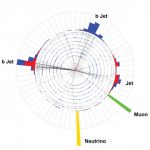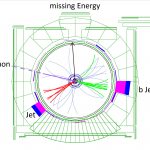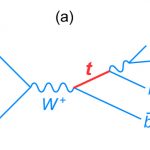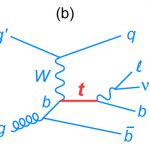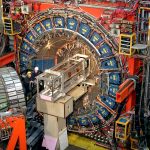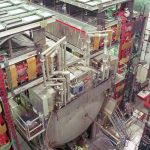Batavia, Ill.—Scientists of the CDF and DZero collaborations at the Department of Energy’s Fermi National Accelerator Laboratory have observed particle collisions that produce single top quarks. The discovery of the single top confirms important parameters of particle physics, including the total number of quarks, and has significance for the ongoing search for the Higgs particle at Fermilab’s Tevatron, currently the world’s most powerful operating particle accelerator.
Previously, top quarks had only been observed when produced by the strong nuclear force. That interaction leads to the production of pairs of top quarks. The production of single top quarks, which involves the weak nuclear force and is harder to identify experimentally, has now been observed, almost 14 years to the day of the top quark discovery in 1995.
Searching for single-top production makes finding a needle in a haystack look easy. Only one in every 20 billion proton-antiproton collisions produces a single top quark. Even worse, the signal of these rare occurrences is easily mimicked by other “background” processes that occur at much higher rates.
“Observation of the single top quark production is an important milestone for the Tevatron program,” said Dr. Dennis Kovar, Associate Director of the Office of Science for High Energy Physics at the U.S. Department of Energy. “Furthermore, the highly sensitive and successful analysis is an important step in the search for the Higgs.”
Discovering the single top quark production presents challenges similar to the Higgs boson search in the need to extract an extremely small signal from a very large background. Advanced analysis techniques pioneered for the single top discovery are now in use for the Higgs boson search. In addition, the single top and the Higgs signals have backgrounds in common, and the single top is itself a background for the Higgs particle.
To make the single-top discovery, physicists of the CDF and DZero collaborations spent years combing independently through the results of proton-antiproton collisions recorded by their experiments, respectively. Each team identified several thousand collision events that looked the way experimenters expect single top events to appear. Sophisticated statistical analysis and detailed background modeling showed that a few hundred collision events produced the real thing. On March 4, the two teams submitted their independent results to Physical Review Letters.
The two collaborations earlier had reported preliminary results on the search for the single top. Since then, experimenters have more than doubled the amount of data analyzed and sharpened selection and analysis techniques, making the discovery possible. For each experiment, the probability that background events have faked the signal is now only one in nearly four million, allowing both collaborations to claim a bona fide discovery that paves the way to more discoveries.
“I am thrilled that CDF and DZero achieved this goal,” said Fermilab Director Pier Oddone. “The two collaborations have been searching for this rare process for the last fifteen years, starting before the discovery of the top quark in 1995. Investigating these subatomic processes in more detail may open a window onto physics phenomena beyond the Standard Model.”
- This collision event display, created by the CDF collaboration, shows a single top quark candidate event. The red arrow indicates the direction of a neutrino and the purple line the direction of a muon escaping from the decay of the top quark. Credit: CDF collaboration
- This proton-antiproton collision, recorded by the DZero collaboration, is among the single top quark candidate events. The top quark decayed and produced a bottom quark jet (b jet), a muon and a neutrino. Credit: DZero collaboration
- Protons and antiprotons comprise quarks, antiquarks and gluons. A proton-antiproton collision can produce a single top quark in two different ways: a quark and an antiquark can create a W boson, which then decays into a top quark and an anti-bottom quark. Or a gluon and a quark interact, with the quark emitting a W boson and the gluon creating a bottom quark and anti-bottom quark. The W boson then interacts with the bottom quark and produces a single top quark. In both cases, the top quark is short-lived and decays, for example, into a bottom quark, a lepton (such as a muon) and a neutrino. Credit: DZero collaboration
- Protons and antiprotons comprise quarks, antiquarks and gluons. A proton-antiproton collision can produce a single top quark in two different ways: a quark and an antiquark can create a W boson, which then decays into a top quark and an anti-bottom quark. Or a gluon and a quark interact, with the quark emitting a W boson and the gluon creating a bottom quark and anti-bottom quark. The W boson then interacts with the bottom quark and produces a single top quark. In both cases, the top quark is short-lived and decays, for example, into a bottom quark, a lepton (such as a muon) and a neutrino. Credit: DZero collaboration
- The Fermilab accelerator complex accelerates protons and antiprotons close to the speed of light. The Tevatron collider, four miles in circumference, produces millions of proton-antiproton collisions per second, maximizing the chance for discovery. Two experiments, CDF and DZero, record the collisions to look for signs of new particles and subatomic processes.
- The CDF detector, about the size of a 3-story house, weighs about 6,000 tons. Its subsystems record the “debris” emerging from each high-energy proton-antiproton collision produced by the Tevatron. The detector records the path, energy and charge of the particles emerging from the collisions. This information can be used to look for particles emerging from the decay of a short-lived top quark.
- The DZero detector records particles emerging from high-energy proton-antiproton collisions produced by the Tevatron. Tracing the particles back to the center of the collision, scientists understand the subatomic processes that take place at the core of proton-antiproton collisions. Scientists search for the tiny fraction of collisions that might have produced single top quarks.
Notes for Editors:
Fermilab, the U.S. Department of Energy’s Fermi National Accelerator Laboratory located near Chicago, operates the Tevatron, the world’s highest-energy particle collider. The Fermi Research Alliance LLC operates Fermilab under a contract with DOE.
CDF is an international experiment of 635 physicists from 63 institutions in 15 countries. DZero is an international experiment conducted by 600 physicists from 90 institutions in 18 countries. Funding for the CDF and DZero experiments comes from DOE’s Office of Science, the National Science Foundation, and a number of international funding agencies.
CDF collaborating institutions are at http://www-cdf.fnal.gov/collaboration/index.html
DZero collaborating institutions are at http://www-d0.fnal.gov/ib/Institutions.html
Copies of the two scientific papers submitted to Physical Review Letters are available at:




